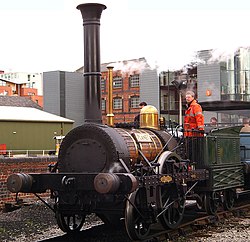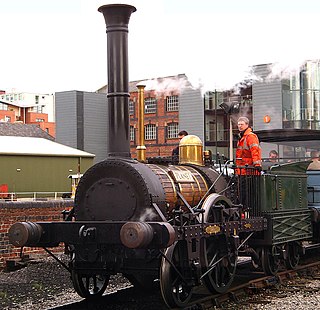
Under the Whyte notation for the classification of steam locomotives, 2-2-0 represents the wheel arrangement of two leading wheels on one axle, two powered driving wheels on one axle, and no trailing wheels. This configuration, which became very popular during the 1830s, was commonly called the Planet type after the first locomotive, Robert Stephenson's Planet of 1830.
The London and North Eastern Railway (LNER) produced several classes of locomotive, mostly to the designs of Nigel Gresley, characterised by a three-cylinder layout with a parallel boiler and round-topped firebox. It produced the most famous locomotive of its day, 4468 'Mallard', the holder of the world steam locomotive speed record. It also built the world-famous 4472 'Flying Scotsman'. However, its locomotive inheritance was much greater than just the 'A4 Class', it also produced highly successful mixed-traffic and freight designs.
Locomotives of the London and North Western Railway. The London and North Western Railway (LNWR) Locomotive Department was headquartered at Crewe from 1862. The Crewe Works had been built in 1840–43 by the Grand Junction Railway (GJR).
Under the Whyte notation for the classification of steam locomotives, 0-2-4 represents the wheel arrangement of no leading wheels, two powered driving wheels on one axle, and four trailing wheels on two axles.

Experiment was a steam locomotive designed and built by Richard Roberts in 1833 for the Liverpool and Manchester Railway (L&MR). The locomotive had vertical cylinders driving via bell cranks.

The London and North Western Railway (LNWR) George the Fifth Class was a class of 4-4-0 passenger steam locomotive.

The London and North Western Railway (LNWR) Prince of Wales Tank Class was a pacific tank engine version of the Prince of Wales Class 4-6-0 steam locomotive.

The London and North Western Railway (LNWR) Experiment Class was a class of 4-6-0 steam locomotive designed by George Whale.

The London and North Western Railway (LNWR) 19in Express Goods Class, otherwise known as the Experiment Goods Class was a class of 4-6-0 steam locomotives. They were essentially a smaller wheeled version of the Whale's Experiment Class and were an early attempt at a mixed traffic engine.
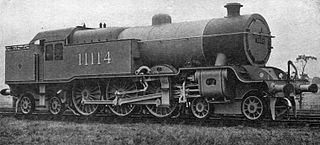
The Lancashire and Yorkshire RailwayHughes 4-6-4T was a class of steam locomotives. They were a 4-6-4T tank engine version of the L&YR Class 8, hence they were known as "Dreadnought tanks".
The North London Railway crane tank was an 0-4-2ST steam locomotive crane tank type. Originally built in 1858 as an 0-4-0ST by Sharp, Stewart and Company for the North and South Western Junction Railway. It was quickly passed to the North London Railway (NLR) who numbered it 37; they renumbered it 29 in 1861 before placing it on the duplicate lst as 29A in 1872. The same year it was rebuilt into an 0-4-2ST with a steam crane carried by the trailing truck. It was subsequently inherited by the London and North Western Railway (LNWR) in January 1922, who allocated it the number 2896; and then in turn the London, Midland and Scottish Railway (LMS) in January 1923. They allocated it the number 7217, but it was June 1926 before it was applied. The LMS placed it on the duplicate list as 27217 in February 1935 before it finally passed to British Railways in 1948. It was allocated the BR number 58865, and renumbered in March 1949. It was the oldest locomotive to be inherited by BR. When finally withdrawn in 1951, it was the oldest surviving standard gauge engine in service with British Railways. It was scrapped at Derby Works in February 1951.

The London and North Western Railway (LNWR) Waterloo Class was a class of 2-4-0 steam locomotives that was also known as the Whitworth Class.

The London and North Western Railway (LNWR) 4ft Shunter was a class of 0-4-0ST steam locomotives. Introduced in 1863 by Ramsbottom, 26 were built in 1863–1865, 10 in 1870, 10 in 1872, and 10 in 1892. The last three of the latter batch were soon rebuilt as 0-4-2ST crane tanks. They survived into LMS ownership in 1923 and the last one was withdrawn in 1933.
The L&YR Class 26 was a class of 20 2-6-2T passenger steam locomotives of the Lancashire and Yorkshire Railway designed by Henry Hoy and introduced in 1903. Most passed to the London, Midland and Scottish Railway (LMS) at the grouping in 1923 though they were withdrawn soon afterwards with none remaining in service after 1926.
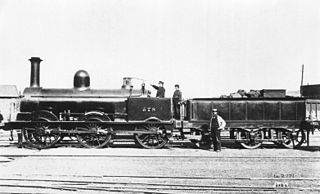
The London and North Western Railway (LNWR) DX Goods class was a class of 0-6-0 steam locomotive, designed by John Ramsbottom for freight duties. 943 were constructed, making them the largest single class of steam locomotives built in the United Kingdom. Despite this, none were preserved.
Locomotives named Ajax have included:

The London and North Western Railway Precedent Class was a class of seventy 2-4-0 steam locomotives originally designed for express passenger work.
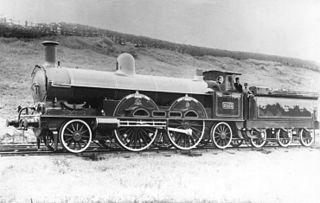
The London and North Western Railway (LNWR) Greater Britain class was a class of ten 2-2-2-2 steam locomotives designed for express passenger work by F. W. Webb.

The 1825 to 1863 Stockton and Darlington Railway (S&DR) was the world's first public railway to use steam locomotives. Its first line connected collieries near Shildon with Stockton-on-Tees and Darlington, and was officially opened on 27 September 1825. While coal waggons were hauled by steam locomotives from the start, passengers were carried in coaches drawn by horses until carriages hauled by steam locomotives were introduced in 1833.

The LNWR Newton Class was a class of ninety-six 2-4-0 steam locomotives built by the London and North Western Railway at their Crewe Works between 1866 and 1873.
